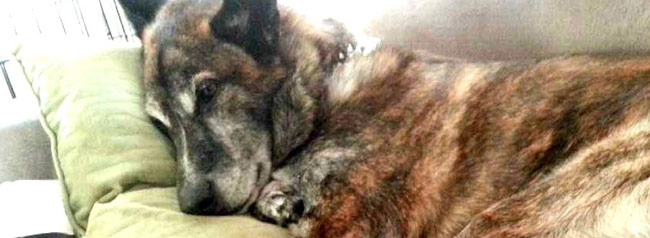
by Crystal Shain, RVT
This sad looking fellow here is Rex. “Why does he look so worried?” you may ask – well, it’s storming outside and he has an extreme anxiety that is very common in dogs when they are exposed to loud noises such as storms and fireworks. It is called ‘storm phobia’ or ‘noise phobia’
His owner Crystal didn’t really know what to do when she first noticed his fear of thunderstorms, so she would comfort him and tell him, “It’s all going to be okay! The storm will pass and you’ll be okay.”Although he appreciated the kind words, they only made his fears worse. He couldn’t hear her words; all he heard was “You’re scared! I’m giving you attention because you are crying. Keep crying, and I’ll give you all the attention you want.”
Sounds like a pretty sweet deal, huh? Whine a little and get attention and snuggles?
Rex’s owner was able to deal with his cries whenever a storm came through, but then his anxiety progressively got worse and worse. Instead of just crying, Rex started to pace the house and wreck belongings. He would run back forth throughout the halls, he would chew on objects he shouldn’t chew, and he would follow Crystal around the house and shake out of his pants (if he wore pants)! He had progressed from nervous to anxious to truly storm phobic.
Eventually, enough was enough! Rex’s antics were starting to put a strain on his life and Crystal’s life. She decided to go see her veterinarian and discuss these problems. That’s when she discovered that Rex is not the only one! 15 million dogs worldwide suffer from noise phobias! What a relief! Now Crystal could figure out how to calm this anxiety and help poor Rex!
She learned how to “train” Rex out of these habits. Whenever there was a storm, instead of paying attention to his behaviour, Crystal would instead ignore Rex when he cried. Her registered veterinary technologist told her that if she tells Rex “it’s okay!” it was actually reinforcing his behaviour, by rewarding his anxious behaviour with attention. Essentially, giving attention (be it words or petting/cuddling) during inappropriate behaviour responses would have the same result as giving Rex a treat during his whining and crying. This type of training is called desensitization.
The desensitization training helped Rex a fair amount, but he still was shaking and pacing around the house. One of the registered veterinary technologists at Rex’s clinic mentioned that they could try using a ThunderShirt to help calm his anxiety. A ThunderShirt is essentially a jacket that wraps around your pet and attaches via Velcro, and is very tight and squeezes their body. There has been a lot of research proving that this method helps calm nerves in dogs, but also in human infants (like swaddling a baby in a blanket). Crystal went and purchased one at her local pet store and it helped drastically. She couldn’t believe the response she got from Rex! Sure, he is still a little fearful of storms, but now he will lay down in the living room and hide his face under the couch. No more pacing, no more crying, no more constant shaking!
If these methods hadn’t worked so well for Rex, Crystal was also given other options by her veterinarian, such as milk casein supplements (such as Zylkene) and pheromone sprays or diffusers (like Adaptil), diets (like MCRC’s Calm) that can help reduce anxiety in a more natural way. Of course, sometimes prescription medical intervention and a veterinary behavioural consultation is needed alongside other methods if the quality of your pet’s life seems to be affected, and your veterinarian can give you those options as well.





